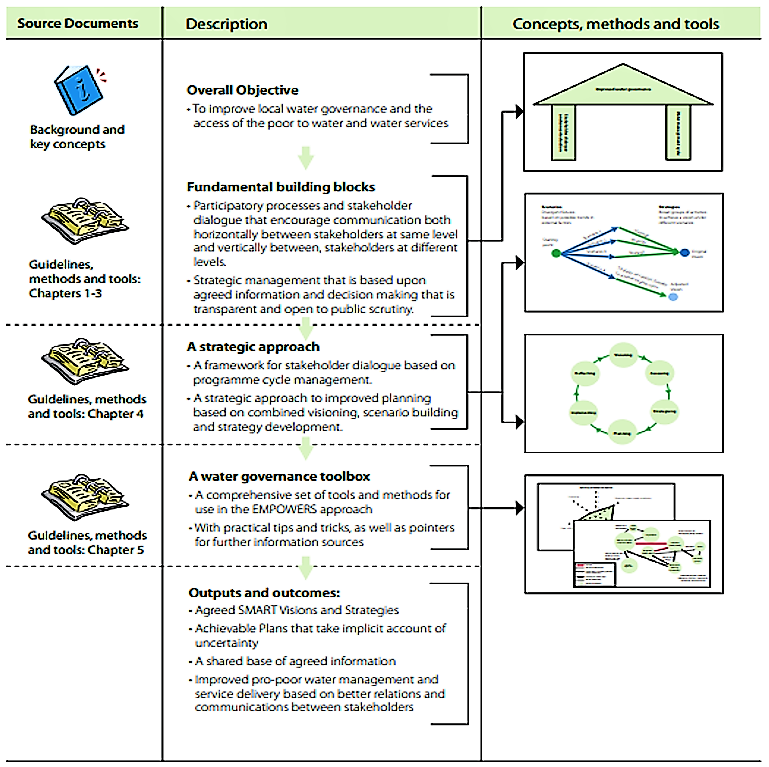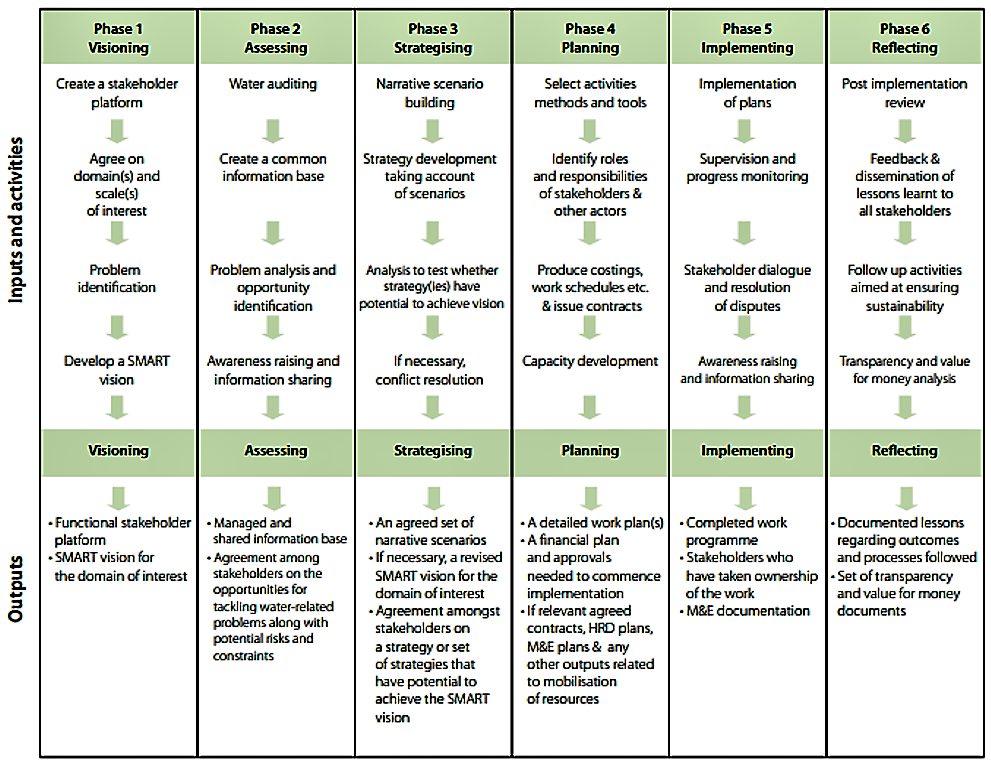EMPOWERS is a regional programme mainly funded by the European Commission's MEDA (Mediterranean Regional Programme for Local Water Management) Water Programme, working in Egypt, Jordan and West Bank and Gaza. The EMPOWERS partnership aims at improving vulnerable populations’ long long-term access and rights to water. For this, it follows a participatory water planning and management process with all stakeholders. The EMPOWERS approach seeks to improve water governance at the local level (water users; communities) and at the intermediate level (decentralised water managements and service providers in districts and states. The Guideline provided by EMPOWERS constitute a practical and logical framework of activities based on the involvement of those who use and manage water, which leads towards improved local water governance and the development and implementation of integrated water development plans for towns, districts and villages. Furthermore, the guidelines advocate collaboration through dialogue to bring about a change in a way that water management professionals and water users work with each other (MORIARTY ET AL. 2007).
Up to now, there has been a lack of practical tools and approaches to tackle water related problems, especially at the local and intermediate levels where water service providers and water users interact. This is the challenge of water governance.
At its simplest, water governance refers to the entire set of systems that control decision making with regard to water resources development and management. In the language of the Global Water Partnership (GWP), water governance “relates to the range of political, social, economic and administrative systems that are in place to develop and manage water resources and the delivery of water services at different levels of society” (ROGERS & HALL 2003) (see e.g. also institutional framework or political and legal framework to learn more about this).
The way EMPOWERS views it, Water Governance specifically focuses on water related issues at the local level. Thereby, the EMPOWERS approach differs essentially from a traditional understanding of Water Management and Governance as a political affair.
The guidelines are divided into five chapters:
Chapter 1 deals with improved water governance. It explains the functioning of water governance and why it is important to consider local and intermediate water governance in the planning process (see above). Furthermore the four main attributes of water governance are explained.
Chapter 2 gives an overview of the approach of EMPOWERS, which was used to design the guidelines. A framework supports stakeholders (see stakeholder analysis starting by the stakeholder identification factsheet) in developing practical outputs such as water development strategies, plans and activities and improved communication and decision making (for more information on these individual steps, see also planning and process tools).
The approach is based on two pillars: the first is a process of stakeholder dialogue and concerted action (SDCA). Well informed stakeholders who communicate with each other on a regular basis will find locally appropriate solutions to pressing water related problems. Hence, the aim is to strengthen communication and make stakeholder dialogues more effective. This can be realised through the identification of key stakeholders and their participation in a stakeholder platform. The second pillar of the approach regards the management cycle itself, which contains of six phases, namely visioning, assessing, strategising, planning, implementing and reflecting. The logic and sequencing of the cycle help to ensure that decisions are based on a clear and logical flow of thought and action. Further details of the management cycle can be seen in table 2.

Chapter 3 deals with the introduction to facilitation and capacity development. The development of capacity among stakeholders, in addition to stakeholder dialogue and the management cycle, is essential for the success of improved water governance. To secure a capacity development, stakeholders need to be advised in a first phase by a facilitation team. The facilitation team is in charge to keep the stakeholders and their projects “on track”. The team will be consisting of experts with different backgrounds and skills. Chapter 4 takes a closer look to the management cycle, shown in table 2. The six phases are described in detail and guidance for implementation is provided, including a list of different tools and methods for each step. In Chapter 5, these tools and methods are explained in detail. For every of the six phases recommended tools are presented, including objectives of each phase, methods to reach these objectives and tips and tricks to facilitate the process.

The focus of the EMPOWERS approach is on participatory water governance at local (community or village) and intermediate (district or governorate) level.
The EMPOWERS approach is mainly used in the middle east; however, the concept can be applied in every country worldwide.
The guideline of EMPOWERS has been tested within villages and towns in Egypt, Jordan and Palestine with a population ranging from a few thousands to 30’000 inhabitants. It has not been tested in larger cities or regions, but there is no reason that the approach would not be suitable on a larger scale.
The guidelines are primarily designed for use in planning and dialogue processes within and between local and intermediate levels; that is, for projects involving more than one village or town. However, elements of the approach are appropriate for use in stand-alone activities within a single municipality.
The EMPOWERS Approach to Water Governance: Background and Key Concepts
The booklet provides an explanation of the conceptual background to the EMPOWERS approach to water governance and is a companion volume to the “EMPOWERS Approach to Water Governance: Guidelines, Methods and Tools”. It helps to develop a deeper understanding of the approach.
MORIARTY, P. BATCHELOR, C. LABAN, P. FAHMY, H. (2007b): INWRDAM The EMPOWERS Approach to Water Governance: Background and Key Concepts. Amman, Jordan: Inter-Islamic Network on Water Resources Development and Management (INWRDAM) URL [Accessed: 18.03.2010]The EMPOWERS Approach to Water Governance: Guidelines, Methods and Tools
The guideline provides information necessary to understand the EMPOWERS approach of water governance and explains in details how to use the approach for planning and implementation of water management and related issues.
MORIARTY, P. BATCHELOR, C. ABD-ALHADI, F. LABAN, P. FAHMY, H. (2007a): INWRDAM The EMPOWERS Approach to Water Governance: Guidelines, Methods and Tools. pdf presentation. Amman, Jordan: Inter-Islamic Network on Water Resources Development and Management (INWRDAM) URL [Accessed: 18.03.2010]Effective water governance. GWP Technical Advisory Committee
The EMPOWERS Approach to Water Governance: Guidelines, Methods and Tools
The guideline provides information necessary to understand the EMPOWERS approach of water governance and explains in details how to use the approach for planning and implementation of water management and related issues.
MORIARTY, P. BATCHELOR, C. ABD-ALHADI, F. LABAN, P. FAHMY, H. (2007a): INWRDAM The EMPOWERS Approach to Water Governance: Guidelines, Methods and Tools. pdf presentation. Amman, Jordan: Inter-Islamic Network on Water Resources Development and Management (INWRDAM) URL [Accessed: 18.03.2010]The EMPOWERS Approach to Water Governance: Background and Key Concepts
The booklet provides an explanation of the conceptual background to the EMPOWERS approach to water governance and is a companion volume to the “EMPOWERS Approach to Water Governance: Guidelines, Methods and Tools”. It helps to develop a deeper understanding of the approach.
MORIARTY, P. BATCHELOR, C. LABAN, P. FAHMY, H. (2007b): INWRDAM The EMPOWERS Approach to Water Governance: Background and Key Concepts. Amman, Jordan: Inter-Islamic Network on Water Resources Development and Management (INWRDAM) URL [Accessed: 18.03.2010]Rmamein Village Case Study
This case study about Rmamein Village in Jordan shows an example how the EMPOWERS approach is implemented in a semi-arid region in the middle east. The village has a population number around 3000, thus it provides a good example for water governance on a local level.
EMPOWERS - INWRDAM (n.y): Rmamein Village Case Study . pdf presentation. EMPOWERS - INWRDAM. [Accessed: 18.03.2010] PDFRweiha Case Study
Another case study of a village in Jordan, which shows issues and challenges of planning and implementation of water governance. Rweiha village is located in an arid region with less than 200 mm rainfall per year and has no independent water sources.
EMPOWERS-INWRDAM (n.y): Rweiha Case Study . pdf presentation. EMPOWERS-INWRDAM. [Accessed: 18.03.2010]Including Marginalised Groups in Equitable Water Management through a Learning Alliance Approach: The EMPOWERS Project
A very detailed case study about the complete EMPOWERS learning and development projects from 2003 to 2007 in Egypt, Jordan and Palestine. Key lessons learnt are provided as well as outcomes of the projects. The paper especially questions the social inclusion of marginalised groups such as the poorest and women.
DA SILVA-WELLS, C. SWITCH (2008): Including Marginalised Groups in Equitable Water Management through a Learning Alliance Approach: The EMPOWERS Project . Delft: Sustainable Water Management Improves Tomorrow’s Cities’ Health URL [Accessed: 18.03.2010]Training Manual for: Pro-poor participatory planning of community water services
The aim of this training manual is to share insights and experience of participatory water resource management approaches and tools, as developed by EMPOWERS and to train participants in specific tools for planning of water development and management projects at local community levels. The training manual operates as a guideline for training courses held by EMPOWERS.
INWRDAM-EMPOWERS (2006): Training Manual for: Pro-poor participatory planning of community water services. INWRDAM-EMPOWERS URL [Accessed: 18.06.2019]

